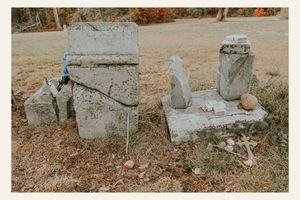
Hidden deep in the pine forests near Grayling, Michigan, the Pere Cheney Cemetery is all that remains of a vanished nineteenth-century lumber town. Visitors have long reported drifting lights between the trees and laughter that doesn’t belong to anyone living. Some say they’ve returned to find tiny handprints on their car windows. Whether or not those stories are true, the tragedy that gave rise to them is real. Pere Cheney was once a thriving community that grew with Michigan’s lumber boom, then fell to disease, fire, and time.
The town began in 1873, when George M. Cheney established a sawmill and rail stop on land granted by the Michigan Central Railroad. Within a year, Pere Cheney had homes, shops, and a hotel offering telegraph service. By the late 1870s it had about 1,500 residents, two sawmills, and a post office, even serving briefly as Crawford County’s seat. But nearby Grayling soon took the title and the railroad hub, leaving Pere Cheney isolated. When the surrounding forests were logged out, the town’s reason for being disappeared.
Then came the disasters. Diphtheria struck in 1893, killing families by the dozens. The cemetery filled faster than it could be tended. Soon after, fire swept through the wooden town, burning mills, homes, and whatever remained of hope. The disease returned in 1897. By 1901 only a handful of residents were left, and by 1912 the post office was closed for good. By 1917, the land was sold off and nature reclaimed the site. Only the graveyard endured.
Today, a sandy track winds through thick forest to a small clearing, the old Pere Cheney Cemetery. Around ninety people are buried here, though few stones remain. Vandals once shattered or stole many markers, and for decades the site was neglected. Local volunteers now maintain it, but the place retains its weathered isolation. Wooden signs ask visitors for respect, warning against trespassing after dark.
The most enduring legend tells of a woman, sometimes a midwife, sometimes an outcast, accused of witchcraft and blamed for the epidemic. Some say she cursed the town before being executed, her grave marked by a red stone that glowed at night. No records confirm the story, but like many legends, it offers explanation where grief left a void.
Today, Pere Cheney is a ghost of memory: a cemetery, a name, and a legend that refuses to fade. Paranormal groups visit in search of voices. Historians come to trace the town’s brief rise and fall. Between the two lies the truth- less about witches and more about the people who lived, worked, and died here. The town is gone. The sorrow remains.

